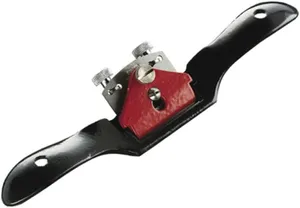WoodItGood is supported by its readers. We may earn an affiliate commission at no extra cost to you if you buy through a link on this page.
Are you learnin’ to shape curves, smooth chair legs, or rounding edges?
If so, then it’s time to talk about one of my favorite tools… the Spokeshave.
This little beauty is perfect for shaping wood with precision, especially when you’re workin’ on curved surfaces that other tools just can’t handle.
But before you rush out to grab your first one, let’s go over what you need to know when buyin’ your first spokeshave.
Our Favorites
Flat vs. Curved Sole: Match the Tool to Your Project
First thing’s first—you’ve got two main types of spokeshaves to choose from: flat sole and curved sole. Which one you pick depends on the kind of work you’re doing.
- Flat Sole Spokeshave: This is the most common and versatile type. If you’re workin’ on relatively flat or slightly curved surfaces, like smoothing the edges of a board or chair legs, this is your go-to tool.
- Curved Sole: If you’re workin’ on tighter curves, like chair spindles or tool handles, a curved sole is your best bet. It allows you to follow the contours of your piece without diggin’ into the wood.
If you’re just startin’ out, I’d suggest goin’ with a flat sole spokeshave first.
It’s more versatile, and once you get the hang of it, you can always add a curved sole version to your toolbox for more specialized work.
Blade Quality: Sharp and Sturdy is the Way to Go
As with any hand tool, the blade is where the magic happens.
A sharp, high-quality blade will give you those smooth, clean shavings you’re after. Look for a spokeshave with blades made from A2 or O1 steel… both are durable and hold an edge well.
Make sure the blade is easy to sharpen, too.
You’ll be shapin’ curves and contours, so a dull blade will leave you frustrated with rough surfaces and tear-out.
Keep that blade sharp, and you’ll be glidin’ through wood like butter.
Blade Adjustment: Fine-Tune for Precision
A good spokeshave should have adjustable blades, so you can set the depth of your cut depending on how much material you want to remove.
Whether you’re takin’ off thick shavings or just fine-tuning a curve, you’ll want that control.
Recommended Reading: Hand Plane Types: A Beginner’s Guide for Woodworkers
Look for a spokeshave with easy-to-use adjustment screws that let you move the blade up and down without too much fuss.
This helps you dial in the perfect cut, so you don’t end up takin’ off more wood than you meant to. Precision is the name of the game with a spokeshave!
Body Material: Metal or Wood?
Spokeshaves come in two main materials, metal and wood, and which one you choose depends on what feels right for you.
- Metal-bodied spokeshaves are more common, and they’re durable and easy to adjust. They’re great for most tasks and tend to last a long time.
- Wooden-bodied spokeshaves are lighter and give a more traditional feel. Some folks prefer the feel of wood, especially for finer work, but they can be a bit trickier to adjust.
If you’re just starting out, I’d recommend a metal-bodied spokeshave for its durability and ease of use. You can always add a wooden one later if you find yourself drawn to that classic feel.
Weight and Balance: Light Enough to Control, Heavy Enough to Cut
The weight of a spokeshave can affect how it feels and how easy it is to control.
You want a tool that’s light enough to maneuver smoothly around curves but heavy enough to stay steady while you work.
A spokeshave that’s too light might feel flimsy, while one that’s too heavy could make fine control harder.
A well-balanced spokeshave should feel like an extension of your hands, allowing you to shape wood with precision without feeling like you’re fighting the tool.
Mouth Size: Keep It Tight for Fine Work
The mouth of the spokeshave is the opening where the blade meets the wood.
A tighter mouth gives you more control and helps reduce tear-out, which is especially important when you’re working on tricky grain or fine details.
Some spokeshaves have an adjustable mouth, which is a nice feature if you’re planning to use the tool for different types of work.
You can open the mouth for thicker shavings or close it up tight for more delicate cuts.
Blade Position: Bevel Up or Down
Now here’s a little detail that can make a big difference: blade position. Most spokeshaves come with the blade bevel facing down, which is great for general work.
It helps control the depth of the cut and makes it easier to avoid tear-out.
But you can also find bevel-up spokeshaves, which give you more control for finer, more delicate work.
If you’re just starting out, stick with a bevel-down model, it’s more forgiving and versatile for everyday use.
So when you’re buyin’ your first spokeshave, remember to consider the sole shape (flat or curved), blade quality, adjustability, body material, handle comfort, blade position, and the overall weight.
Gettin’ the right spokeshave will make all the difference when you’re shapin’ and smoothin’ those beautiful curves on your woodworking projects.
That’s enough talk about spokeshaves for today! If you’ve got any more questions, just holler, and I’ll get back to you quicker than a squirrel runnin’ up a walnut tree. Happy shavin’, y’all!





